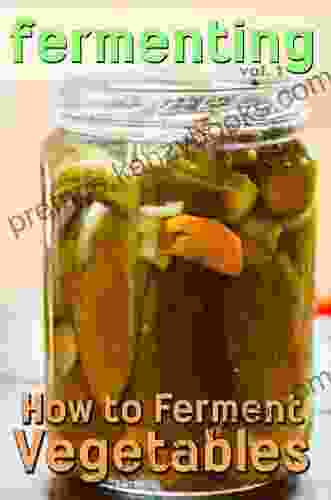Fermenting: The Art and Science of Preserving Food

Fermentation is an ancient technique for preserving food that is making a comeback in the modern kitchen. This book will teach you everything you need to know to get started, from the basics of fermentation to more advanced techniques.
4.5 out of 5
| Language | : | English |
| File size | : | 2976 KB |
| Text-to-Speech | : | Enabled |
| Screen Reader | : | Supported |
| Enhanced typesetting | : | Enabled |
| X-Ray | : | Enabled |
| Word Wise | : | Enabled |
| Print length | : | 128 pages |
| Lending | : | Enabled |
What is Fermentation?
Fermentation is a metabolic process that converts organic compounds into acids, gases, or alcohol. It is caused by the action of microorganisms such as bacteria, yeasts, and molds.
Fermentation has been used for centuries to preserve food. It is a natural process that does not require the use of chemicals or preservatives.
Types of Fermentation
There are many different types of fermentation, each of which produces a different type of food. Some of the most common types of fermentation include:
- Lactic acid fermentation: This type of fermentation is used to make sauerkraut, kimchi, and yogurt. It is caused by the action of lactic acid bacteria, which convert lactose into lactic acid.
- Acetic acid fermentation: This type of fermentation is used to make vinegar. It is caused by the action of acetic acid bacteria, which convert ethanol into acetic acid.
- Alcoholic fermentation: This type of fermentation is used to make beer, wine, and cider. It is caused by the action of yeast, which convert sugars into alcohol and carbon dioxide.
Benefits of Fermented Foods
Fermented foods are a healthy addition to any diet. They are a source of probiotics, which are beneficial bacteria that can help to improve gut health. Fermented foods are also a good source of vitamins, minerals, and antioxidants.
Some of the benefits of eating fermented foods include:
- Improved gut health
- Boosted immunity
- Reduced inflammation
- Improved mood
- Increased energy
How to Ferment Vegetables
Fermenting vegetables is a simple process that can be done at home. Here is a step-by-step guide to fermenting vegetables:
- Choose your vegetables. Almost any vegetable can be fermented, but some of the most popular choices include cabbage, carrots, beets, and cucumbers.
- Wash and cut the vegetables. Wash the vegetables thoroughly and cut them into bite-sized pieces.
- Add salt. Add 1 tablespoon of salt to every pound of vegetables.
- Mix the vegetables and salt together. Place the vegetables and salt in a large bowl and mix them together thoroughly.
- Pack the vegetables into a jar. Pack the vegetables into a clean glass jar. Leave about 1 inch of headspace at the top of the jar.
- Cover the vegetables with a weight. Place a weight on top of the vegetables to keep them submerged under the brine.
- Ferment the vegetables at room temperature for 1-2 weeks. The fermentation time will vary depending on the type of vegetables you are fermenting and the temperature of your kitchen.
- Check the vegetables regularly. Check the vegetables every few days to make sure they are fermenting properly. The vegetables should be submerged under the brine and should not have any mold growing on them.
- Once the vegetables are fermented, store them in the refrigerator for up to 6 months.
Troubleshooting
If you are having trouble fermenting vegetables, here are some tips:
- Make sure you are using the right salt. Not all salts are created equal. Use a fine-grained sea salt or kosher salt for fermenting vegetables.
- Make sure the vegetables are submerged under the brine. If the vegetables are not submerged under the brine, they will not ferment properly.
- Keep the vegetables at the right temperature. The ideal temperature for fermenting vegetables is between 65-75 degrees Fahrenheit.
- Be patient. Fermentation takes time. Don't expect your vegetables to be fermented overnight.
Fermenting vegetables is a simple and rewarding process that can add a healthy and delicious element to your diet. With a little practice, you can master the art of fermentation and enjoy the benefits of fermented foods for years to come.
4.5 out of 5
| Language | : | English |
| File size | : | 2976 KB |
| Text-to-Speech | : | Enabled |
| Screen Reader | : | Supported |
| Enhanced typesetting | : | Enabled |
| X-Ray | : | Enabled |
| Word Wise | : | Enabled |
| Print length | : | 128 pages |
| Lending | : | Enabled |
Do you want to contribute by writing guest posts on this blog?
Please contact us and send us a resume of previous articles that you have written.
 Book
Book Novel
Novel Page
Page Chapter
Chapter Text
Text Story
Story Genre
Genre Reader
Reader Library
Library Paperback
Paperback E-book
E-book Magazine
Magazine Newspaper
Newspaper Paragraph
Paragraph Sentence
Sentence Bookmark
Bookmark Shelf
Shelf Glossary
Glossary Bibliography
Bibliography Foreword
Foreword Preface
Preface Synopsis
Synopsis Annotation
Annotation Footnote
Footnote Manuscript
Manuscript Scroll
Scroll Codex
Codex Tome
Tome Bestseller
Bestseller Classics
Classics Library card
Library card Narrative
Narrative Biography
Biography Autobiography
Autobiography Memoir
Memoir Reference
Reference Encyclopedia
Encyclopedia Jonathan Stegall
Jonathan Stegall Kat Fowler
Kat Fowler Nicole D Richards
Nicole D Richards Hal Borland
Hal Borland Jeremiah Crowley
Jeremiah Crowley Steve Hendershot
Steve Hendershot Paula Wiseman
Paula Wiseman Jen Rulon
Jen Rulon Kathleen Fearn Banks
Kathleen Fearn Banks Gretchen Scalpi
Gretchen Scalpi Nik Speakman
Nik Speakman Jason Reynolds
Jason Reynolds Jenny Kings
Jenny Kings Vanessa F Hurst
Vanessa F Hurst Paul Laursen
Paul Laursen Hannah Kaminsky
Hannah Kaminsky Nathalie C Zeitouni
Nathalie C Zeitouni Jay Brown
Jay Brown Guy Lecky Thompson
Guy Lecky Thompson Inna Lukyanovsky
Inna Lukyanovsky
Light bulbAdvertise smarter! Our strategic ad space ensures maximum exposure. Reserve your spot today!

 Simon MitchellSimple Homemade Essential Oils: Natural Remedies to Enhance Your Health and...
Simon MitchellSimple Homemade Essential Oils: Natural Remedies to Enhance Your Health and...
 Peter CarterPrepare for the Undead Onslaught: Delve into the Epic Lg City Comic Book Swat...
Peter CarterPrepare for the Undead Onslaught: Delve into the Epic Lg City Comic Book Swat... Eric NelsonFollow ·6.1k
Eric NelsonFollow ·6.1k Stephen KingFollow ·11.5k
Stephen KingFollow ·11.5k Pete BlairFollow ·19.7k
Pete BlairFollow ·19.7k John KeatsFollow ·15.5k
John KeatsFollow ·15.5k Brandon CoxFollow ·8.1k
Brandon CoxFollow ·8.1k Hassan CoxFollow ·4.9k
Hassan CoxFollow ·4.9k Jeffrey HayesFollow ·13.5k
Jeffrey HayesFollow ·13.5k Vic ParkerFollow ·19.3k
Vic ParkerFollow ·19.3k

 Julian Powell
Julian PowellUnleash Your Inner Adonis: The Ultimate Guide to...
Are you ready to...

 Josh Carter
Josh CarterJourney into Enchanting Tales: Tales From The Brothers...
Discover a Literary...

 Robbie Carter
Robbie CarterUnlock Your Culinary Potential: The Best Guide for...
Embark on a culinary adventure with The...

 Colby Cox
Colby CoxUnlock Culinary Delights: 25 Effortless Vegetable Side...
Are you ready to embark on a culinary...

 Joseph Foster
Joseph FosterHow to Plan the Perfect Party: A Comprehensive Guide to...
Are you tired of throwing the...
4.5 out of 5
| Language | : | English |
| File size | : | 2976 KB |
| Text-to-Speech | : | Enabled |
| Screen Reader | : | Supported |
| Enhanced typesetting | : | Enabled |
| X-Ray | : | Enabled |
| Word Wise | : | Enabled |
| Print length | : | 128 pages |
| Lending | : | Enabled |









